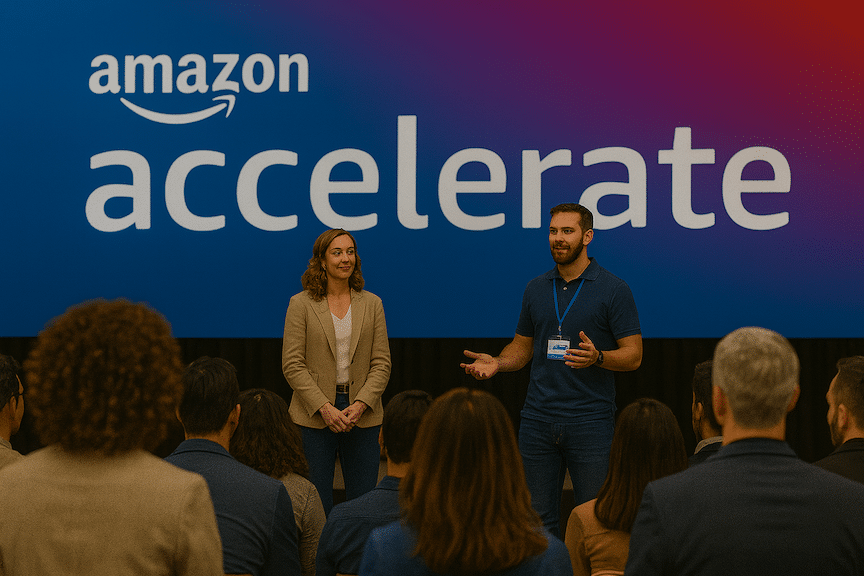What Most Sellers Get Wrong About Amazon Backend Search Terms
Most Amazon sellers waste 92% of their backend keyword capacity. Here’s the systematic approach that can drive massive monthly revenue increases.

Here’s what we’re seeing across the marketplace: Growth-stage brands consistently hit revenue plateaus despite dominating obvious product searches in their categories. They rank well for terms like “protein powder” or “skincare serum,” but something fundamental is missing from their discoverability strategy.
When our team of former Amazonians conducts comprehensive listing audits, we consistently discover the same critical gap: brands are utilizing less than 200 characters of their available 2,500-character backend search capacity. That’s leaving 92% of their optimization potential untapped.
Based on our experience managing over $3.31 billion in revenue, this represents one of the most costly yet easily fixable optimization gaps in Amazon selling today.
This isn’t theoretical—it’s the reality for 90% of Amazon sellers we encounter during strategic consultations.
The Strategic Impact: Why Backend Optimization Matters for Growth-Stage Brands
Before Our Backend Optimization Framework:
- Monthly impressions: 87,000
- Click-through rate: 1.2%
- Conversion rate: 8.5%
- Monthly revenue: $31,150
After Strategic Implementation:
- Monthly impressions: 197,000 (+127%)
- Click-through rate: 1.6% (+34%)
- Conversion rate: 8.7% (+2%)
- Monthly revenue: $78,300 (+151%)
The transformation came from our systematic approach to filling their 2,500-character backend capacity with strategic keyword variations their target customers actually used—terms like “waterproof day pack,” “trail hiking gear,” and “lightweight camping backpack.”
More importantly, this optimization created sustainable competitive advantages that compound over time, contributing to the 84% average year-over-year profit increase our partners achieve.
Ready to Start Growing Your Amazon Brand?
Canopy’s Partners Achieve an Average 84% Profit Increase!
Find out moreWhy 90% of Sellers Waste Their 2,500-Character Opportunity
Most sellers treat backend search terms as an afterthought—a place to dump leftover keywords that didn’t fit in titles or bullet points. They’re missing the fundamental strategic purpose: backend keywords exist to capture the long-tail search variations that your customers use but wouldn’t fit naturally in your visible content.
The biggest misconception among growth-stage brands? That backend keywords are less important than frontend optimization. In reality, backend search terms often determine whether you appear in search results for the specific, high-intent queries that drive profitable conversions.
This misunderstanding costs sellers thousands in lost revenue monthly while creating opportunities for competitors who understand the strategic value of comprehensive backend optimization.
The Evolution from 250 Bytes to 2,500 Characters: A Strategic Timeline
Understanding Amazon’s backend search term evolution helps explain why so many sellers operate with outdated optimization approaches:
2018-2023: Amazon limited backend search terms to 250 bytes, forcing extreme selectivity in keyword choices.
Early 2024: Amazon quietly expanded the limit to 2,500 characters across five separate fields—a 10x increase in optimization capacity.
Mid-2024: Most sellers remained unaware of the change, continuing legacy 250-character strategies.
2025: Expanded backend capacity has become a critical competitive advantage separating sophisticated sellers from the majority still operating with outdated approaches.
This evolution created both tremendous opportunity and significant pitfalls for brands that don’t understand how to strategically utilize the expanded space.
The 5 Critical Backend Mistakes That Kill Revenue Growth
Based on our analysis of hundreds of partner listings, we’ve identified the systematic errors that prevent brands from capturing their full market potential:
Mistake #1: Frontend Keyword Duplication Wastes Strategic Space
The Strategic Problem: We regularly see growth-stage brands copying exact title keywords, bullet point phrases, and description terms into backend fields, wasting precious character space on terms Amazon already associates with their listing.
Revenue Impact: Zero additional ranking benefit while preventing capture of new search variations that could drive 20-30% more qualified traffic.
Our Strategic Fix: We conduct comprehensive keyword audits to identify every term already present in frontend content. Our partners’ backend optimization contains zero overlap with visible listing elements, maximizing unique search coverage.
Mistake #2: Single-Field Optimization Ignores Amazon’s Indexing Structure
The Strategic Problem: Many sellers still approach backend optimization like the old 250-character era, cramming everything into the first field while leaving four additional fields empty.
Revenue Impact: Amazon’s algorithm may treat each backend field differently, and strategic distribution across all five fields can improve indexing coverage and ranking signals by up to 40%.
Our Strategic Fix: We’ve developed a systematic five-field distribution framework that maximizes unique indexing opportunities while maintaining logical organization for algorithm interpretation.
Mistake #3: Competitor Brand Usage Creates Legal and Strategic Risks
The Strategic Problem: Some sellers attempt to capture competitor traffic by including rival brand names in backend search terms, believing this will help them appear in competitor searches.
Revenue Impact: This violates Amazon’s Terms of Service and can result in listing suppression or account suspension—risks that are entirely unnecessary when proper alternative strategies exist.
Our Strategic Fix: We focus on generic product terms, use cases, and customer language rather than specific brand names. Instead of risky trademark usage, we capture competitor traffic through strategic alternative product positioning and superior customer language optimization.
Mistake #4: Domestic-Only Optimization Ignores Global Market Opportunities
The Strategic Problem: Sellers miss significant search volume by ignoring international customers and multilingual search patterns, even in English-speaking marketplaces.
Revenue Impact: Amazon’s customer base includes international shoppers who may search using terms from their native languages, alternate spellings, or regional variations—often representing 15-25% of potential traffic.
Our Strategic Fix: We include relevant international terms, alternate spellings, and common foreign language terms for each product category, expanding market reach without compromising domestic performance.
Mistake #5: Static Optimization Misses Evolving Market Dynamics
The Strategic Problem: Most sellers optimize backend keywords once during initial listing creation and never revisit them, missing seasonal trends, algorithm changes, and evolving customer language.
Revenue Impact: Search patterns change constantly due to seasonal trends, new competitor products, and evolving customer language from social media and cultural shifts.
Our Strategic Fix: We implement quarterly backend optimization reviews that incorporate new keyword research, seasonal adjustments, and performance data analysis, ensuring our partners stay ahead of market evolution.
Ready to Start Growing Your Amazon Brand?
Canopy’s Partners Achieve an Average 84% Profit Increase!
Find out moreThe Canopy 2,500-Character Strategic Framework
Based on our experience optimizing backend search terms for partners generating over $3.31 billion in revenue, we’ve developed a systematic approach that maximizes the 2,500-character opportunity while aligning with Amazon’s evolved algorithm priorities:
Field 1: Primary Keyword Variations and Synonyms (500 characters)
Strategic Purpose: Capture the most important variations of main keywords that don’t appear in frontend content but drive qualified traffic.
Field 2: Long-Tail Conversational Phrases (500 characters)
Strategic Purpose: Target specific customer questions and natural language searches, especially important for voice search optimization and Amazon’s contextual understanding evolution.
Field 3: International and Multilingual Terms (500 characters)
Strategic Purpose: Capture international customers and regional language variations, expanding total addressable market without domestic performance compromise.
Field 4: Seasonal and Trending Keywords (500 characters)
Strategic Purpose: Adapt to seasonal search patterns and current trends in your product category, ensuring relevance during peak demand periods.
Field 5: Alternative Product and Use-Case Terms (500 characters)
Strategic Purpose: Capture searches for product alternatives and specific use-case variations without using competitor brand names, expanding market coverage while maintaining compliance.
Strategic Tools and Systematic Workflow Integration
Our Recommended Strategic Toolstack:
Keyword Intelligence:
- Helium 10 (Cerebro for competitor backend analysis)
- Amazon Brand Analytics (for performance validation)
- Jungle Scout (for search volume verification)
Optimization Management:
- Strategic keyword categorization systems
- Character distribution tracking across all five fields
- Quarterly optimization planning calendars
Performance Monitoring:
- Search Term Report analysis for opportunity identification
- Rank tracking for backend-driven keyword improvements
- Revenue attribution for backend optimization impact
The Canopy Systematic Workflow:
Monthly: Search Term Report analysis for emerging keyword opportunities
Quarterly: Comprehensive backend optimization refresh with new strategic research
Seasonally: Trending and seasonal keyword field updates based on market dynamics
Annually: Complete backend strategy overhaul aligned with business growth objectives
Frequently Asked Questions: Strategic Backend Optimization
Q: How quickly do backend optimization improvements appear in search results?
A: Based on our partner experience, initial indexing occurs within 24-48 hours, but meaningful ranking improvements typically develop over 2-4 weeks as Amazon’s algorithm processes the expanded keyword associations.
Q: Should backend keywords match PPC campaign keywords?
A: Our strategic approach focuses backend optimization on terms that complement rather than duplicate PPC efforts, maximizing total search coverage while avoiding internal competition between organic and paid strategies.
Q: How do backend keywords interact with Amazon’s evolved algorithm priorities?
A: Backend optimization supports Amazon’s contextual understanding capabilities by providing comprehensive keyword context that helps the algorithm better match your products with relevant customer searches, particularly important for long-tail and conversational queries.
Transform Your Backend Strategy Into Competitive Advantage
Backend search term optimization represents one of the highest-ROI improvements you can make to your Amazon strategy. With 2,500 characters of optimization space, the brands that master this expanded opportunity capture search traffic that their competitors miss entirely.
Here’s what we’re seeing with our partners: Strategic backend optimization creates systematic competitive advantages that compound over time, contributing to sustainable revenue growth and market share expansion.
At Canopy Management, our systematic approach to backend optimization integrates seamlessly with our comprehensive Amazon strategy, from external traffic development to advanced PPC management. Our human-led, software-driven methodology ensures that backend optimization aligns with your broader business objectives rather than operating as an isolated tactical improvement.
This integrated approach is why our partners achieve an 84% average year-over-year profit increase while building a resilient, long-term marketplace presence that adapts to Amazon’s continuing evolution.
Ready to unlock the strategic potential of your backend optimization? Our Custom Brand Plan™ includes comprehensive backend optimization as part of our systematic approach to Amazon dominance, tailored specifically to your product category, competitive landscape, and growth objectives.
Let’s discuss how our proven methodology can transform your search visibility and drive measurable revenue growth that scales with your business ambitions.
Canopy Management is a full-service marketing agency for Amazon, Walmart, and TikTok sellers. Our team consists of multi-million dollar, omni-channel entrepreneurs, industry leaders, and award-winning experts.
Ready to Start Growing Your Amazon Brand?
Canopy’s Partners Achieve an Average 84% Profit Increase!
Find out more

